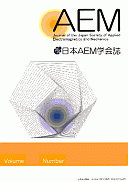Volume 31, Issue 4
Displaying 1-8 of 8 articles from this issue
- |<
- <
- 1
- >
- >|
Special Topic: Vital Sign Monitoring Techniques
-
2023Volume 31Issue 4 Pages 497-
Published: 2023
Released on J-STAGE: January 24, 2024
Download PDF (647K) -
2023Volume 31Issue 4 Pages 498-503
Published: 2023
Released on J-STAGE: January 24, 2024
Download PDF (1501K) -
2023Volume 31Issue 4 Pages 504-509
Published: 2023
Released on J-STAGE: January 24, 2024
Download PDF (2643K) -
2023Volume 31Issue 4 Pages 510-516
Published: 2023
Released on J-STAGE: January 24, 2024
Download PDF (2032K) -
2023Volume 31Issue 4 Pages 517-524
Published: 2023
Released on J-STAGE: January 24, 2024
Download PDF (2367K) -
2023Volume 31Issue 4 Pages 525-530
Published: 2023
Released on J-STAGE: January 24, 2024
Download PDF (1678K)
Regular Paper[Academic Papers]
-
2023Volume 31Issue 4 Pages 531-541
Published: 2023
Released on J-STAGE: January 24, 2024
Download PDF (3132K)
Book Review
-
2023Volume 31Issue 4 Pages 542-
Published: 2023
Released on J-STAGE: January 24, 2024
Download PDF (653K)
- |<
- <
- 1
- >
- >|
